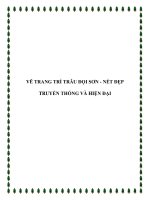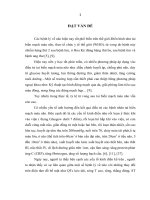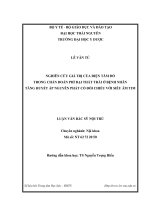Theo dõi điện tâm đồ truyền thống (holter), lâu dài (loop) hay từ xa (tele) biện pháp nào sẽ có ý nghĩa hơn cả
Bạn đang xem bản rút gọn của tài liệu. Xem và tải ngay bản đầy đủ của tài liệu tại đây (2.6 MB, 32 trang )
EKG monitoring : Holter, loop
recorder or telemedicine should be
relevant
DR SOFIAN JOHAR
CONSULTANT CARDIOLOGIST AND
ELECTROPHYSIOLOGIST
RIPAS HOSPITAL AND GLENEAGLES JPMC
BRUNEI DARUSSALAM
Holter monitoring
•
•
•
•
Usually 24-48h
2-3 bipolar leads
5-7 electrodes
Common channels
– Modified V5
– Modified V3
– Modified inferior lead
Loop recorder
• Can be worn for prolonged periods of time
– 2-4 weeks
– Record ECGs in a continuous manner but store a
brief period when activated by patient
– Also auto-trigger
– Advantageous when patient is very symptomatic
/ syncopal during episodes
– Can transmit information over telephone lines
Event recorder
• Can be used for prolonged periods of time
– 2-4 weeks to months
– Relies on rapid placement of electrodes /device
during episodes
– May be useful when patients are not too
symptomatic during episodes
– Can transmit over telephone lines
Implantable loop recorders
• Implanted subcutaneously
– Examples include
• Medronic
– REVEAL
– LINQ
• St Jude
– Confirm
• Batteries last 2-3 years
• Useful when symptoms are intermittent or
when prolonged monitoring is required
Indications for ambulatory monitoring
– Palpitations
– Syncope
– Chest pain
– Evaluation of anti-arrhythmic therapy
– Unexplained SOB/fatigue
– Evaluation in patient with unexplained stroke
– Monitoring atrial fibrillation ablation
Indications for Ambulatory ECG to
assess symptoms possibly related to
rhythm disturbances
• Class I
– Patients with unexplained syncope, near syncope
or episodic dizziness in whom the cause is not
obvious
– Patients with unexplained recurrent palpitations
• Class IIb
– Patients with episodic shortness of breath, chest
pain or fatigue that is not otherwise explained
– Patients with neurological events when transient
atrial fibrillation or flutter is suspected
– Patients with symptoms such as syncope, near
syncope, episodic dizziness, or palpitation in whom a
probable cause other than arrhythmia has been
identified but in whom symptoms persist despite
treatment if this other cause
• Class III
– Patients with symptoms such as syncope, near
syncope, episodic dizziness, or palpitation in whom
other causes have been identified by history,
physical examination or laboratory tests
– Patients with CVA, without other evidence of
arrhythmia
Assessment of risk in patients without
symptoms of arrhythmias
• After myocardial infarction
• Congestive heart failure
• Genetic heart disorders
– Hypertrophic cardiomyopathies
– Arrhythmogenic right ventricular
cardiomyopathy
– Primary arrhythmia disorders
• Brugada Syndrome
• Long QT
Indications for AECG
• Class I
– None
• Class Iib
– Post-MI patients with LV dysfunction
– Patients with CHF
– Patients with idiopathic hypertrophic
cardiomyopathy
• Efficacy of anti-arrhythmic drug therapy
• Assessment of pacemaker and ICD function
– Less necessary with use of modern devices
• Monitoring for myocardial ischaemia
Implantable loop recorders
Implantable loop recorders
Implantable loop recorders
Current Report: Trends
Patient: SURAINI SHARIL .
Received: 08-Oct-2016 00:05:00
14 Month Cardiac Compass
SURAINI SHARIL .
10-Aug-2015 to 08-Oct-2016
Longest AF (last 14 months): (ID# 633) 05-Nov-2015, Duration: 04:38:00
Medtronic CareLink Network
Copyright © 2001-2016 Medtronic, Inc.
Confidential Patient Information
LNQ11 Serial Number: RLA706048S
Patient ID: G-009269
08-Oct-2016 17:43:41
1/1
Which to choose?
• Choice depends on nature of symptoms
– Holters are very cheap
– Yield is low
• With intermittent symptoms
– External loop recorders / event recorders
probably more useful
• Implantable loop recorders
– Very useful for prolonged monitoring
– Small risk of infection
Diagnostic yield
• Syncope (1-26%)
• Palpitations (0-44%)
Palpitations
Peter Zimetbaum, and Alena Goldman Circulation.
2010;122:1629-1636
Syncope
Peter Zimetbaum, and Alena Goldman Circulation.
2010;122:1629-1636
AF and stroke
• Atrial fibrillation and flutter (AF) account for ≈10% of all strokes and
50% of cardioembolic strokes
• Stroke associated with AF carries a poor prognosis as more than
50% of the survivors remain with a severe deficit, and recurrence
may be as high as 12% per year
• Because anticoagulant treatment dramatically reduces the
recurrence rate, detection of this arrhythmia after stroke is
essential
• Unfortunately, AF remains underdiagnosed as it is often
asymptomatic: up to 30% of patients with AF are unaware of their
diagnosis
• 25% of those with AF-associated stroke have no prior diagnosis of
AF
• AF pattern is intermittent in 30% of patients with stroke and may
not appear on a single recording
AF and stroke
• The AF detection rate with 12-lead ECG ranges
between 2 and 5% after ischemic stroke or
transient ischemic stroke (TIA)
• 2 and 6% if a 24-hour Holter device is used
EMBRACE
CRYSTAL-AF
Patients enrolled - n
572
447
Mean age in years ±SD
72.5 ± 8.5
61.5 ± 11.3
Median CHADS2 Score of all
patients
3
3
Hypertension in intervention
group - n/n total IG(%)
204/286 (71.3%)
144/221 (65.2%)
Diabetes mellitus in intervention
group - n/n total IG(%)
Monitoring device in
intervention group
Invasive insertion of device
required
Primary endpoint
55/286 (19.2%)
34/221 (15.4%)
30 day event-triggered loop
recorder from Braemar (ER910AF insertable cardiac monitor from
Cardiac Event Monitor)
Medtronic (REVEAL XT)
No
newly detected AF lasting >30s
within 90 days after
randomisation
Yes
time to first detection of AF
(lasting >30s) within 6 months









